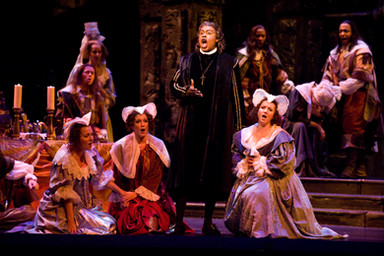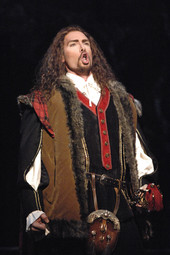FWO Archives: Donizetti's 'Lucia di Lammermoor' (2008 Festival)
- Fort Worth Opera
- Oct 15, 2020
- 9 min read
Donizetti's haunting bel canto tragedy has captivated audiences for over 180 years, with its riveting tale of unrequited love, feuding families in the Scottish Highlands, and one woman's spiraling, bloody descent into madness. Director David Gately's sumptuous Lucia, with Metropolitan Opera star Elizabeth Futral and young, rising tenor Stephen Costello, was a stunning highlight of the 2008 Festival.

SYNOPSIS

Act I
In a ruined park near Lammermoor Castle, Enrico's retainers prepare to search for a mysterious trespasser. Norman no, captain of the guard, remains behind to greet Enrico, who decries Lucia's refusal to marry Arturo. When the girl's elderly tutor, Raimondo, suggests that grief over her mother's death keeps her from thoughts of love, Normanno reveals that Lucia has been discovered keeping trysts with a hunter who saved her from a raging bull. He suspects the stranger is none other than Edgardo. Enrico rages, and as retainers confirm Normanno's suspicions, he swears vengeance. At a fountain near her mother's tomb, Lucia, fearful of her brother, awaits a rendezvous with Edgardo. She tells her confidante, Alisa, the tale of a maiden's ghost that haunts the fountain and has warned her of a tragic end to her love for Edgardo. Though Alisa implores her to take care, Lucia cannot restrain her love. On arrival, Edgardo explains he must go to France on a political mission but wishes to reconcile himself with Enrico so he and Lucia may marry. Lucia, knowing her brother will not relent, begs Edgardo to keep their love a secret. Though infuriated at Enrico's persecution, he agrees. The lovers seal their vows by exchanging rings, then bid each other farewell.


Act II
In an anteroom of Lammermoor Castle, Enrico plots with Norman no to force Lucia to marry Arturo. As the captain goes off to greet the bridegroom, Lucia enters, distraught but defiant, only to be shown a forged letter, supposedly from Edgardo, proving him pledged to another. Crushed, she longs for death, but Enrico insists on her marrying at once to save the family fortunes. Now Raimondo urges her to consent to the wedding, invoking the memory of her mother and asking her to respect the family's desperate situation. When she yields, he reminds her there are heavenly rewards for earthly sacrifices. In the great hall of Lammermoor, as guests hail the union of two important families, Arturo pledges to restore the Ashtons' prestige. Enrico prepares him for Lucia's melancholy by pleading her grief over her mother's death. No sooner has the girl entered and been forced to sign the marriage contract than Edgardo bursts in. Returning earlier than expected, he has learned of the wedding and come to claim his bride. Bloodshed is averted only when Raimondo commands the rivals to put up their swords. Seeing Lucia's signature on the contract, Edgardo tears his ring from her finger, curses her and rushes from the hall. Hardly comprehending his words, Lucia collapses.

Act III

Edgardo sits in a chamber at the foot of Wolf's Crag tower, deep in thought, as a storm rages. Enrico rides there to confront him, and the flames of their enmity flare. They agree to meet at dawn among the tombs of the Ravenswoods to fight a duel. The continuing wedding festivities are halted when Raimondo enters to announce that Lucia, gone mad, has stabbed and killed Arturo in the bridal chamber. Disheveled, unaware of what she has done, she wanders in, recalling her meetings with Edgardo and imagining herself married to him. When the angry Enrico rushes in, he is silenced by the sight of her pitiful condition. Believing herself in heaven, Lucia falls dying. Among the tombs of his ancestors, Edgardo, last of the Ravenswoods, laments Lucia's supposed betrayal and awaits his duel with Enrico, which he hopes will end his own life. Guests leaving Lammermoor Castle tell Edgardo the dying Lucia has called his name. As he is about to rush to her side, Raimondo arrives to tell of her death, and her bier is carried past. Resolving to join Lucia in heaven, Edgardo stabs himself and dies.

PROGRAM NOTES

It's the story of a deranged bride who stabs her husband to death on their wedding night and then stumbles around the castle in a bloody nightgown, singing hysterically and swinging the murder weapon around, while her horrified guests choke on their hors d'oeuvres. In Scotland. A long time ago. On paper, Gaetano Donizetti's masterpiece Lucia di Lammermoor sounds more like a low-budget slasher film than a great opera. But this immortal tragedy is not only one of the most beloved works in the repertoire, it is also a defining work in a number of ways-defining its composer and serving as the ultimate showcase of the bel canto style and coloratura voice.

THE COMPOSER
Gaetano Donizetti was born into dire poverty in Bergamo, Italy, in 1797. But his musical talents blossomed early and, at age nine, he was able to enter a newly established, local music school for poor children. He later continued his studies in Bologna, but returned to Bergamo in 1817 to compose operas for a local company.

Donizetti's early operas may not have been written well-few of them enjoyed much success in his lifetime and almost all are completely forgotten today-because they were written quickly. He established himself early on as a composer who could churn out notes at a blinding rate and never let up, composing more than 70 operas in a career that spanned only about 25 years. So it is little wonder that the young Donizetti found steady work as a composer for various opera companies around Italy-producers never worried about a missed deadline.
But while his work in the early years was steady, it was also unspectacular. Many feel that these early works lack distinction because Donizetti was overly influenced by Rossini, the undisputed titan of Italian opera of that time. But, if that was the case, Donizetti broke out from under the shadow of Rossini with Anna Bolena, the tragic tale of Henry Vlll's ill-fated second wife, which debuted in Milan in 1830. At the age of 32, he was finally finding his own voice as a composer and was rewarded with his first major success.

Anna Bolena was the beginning of the middle period of Donizetti's career, during which he continued to crank out operas at an amazing clip, but with much better results. His most notable works from this time were The Elixir of Love (1832) and Lucia di Lammermoor (1835). It was during this period that he was rivaled only by Rossini and Bellini for the title of Italy's greatest opera composer. And Lucia played a major role in granting him admission to this near-holy trinity. Based on a novel by Sir Walter Scott, the opera is seen as the embodiment of the Romantic sensibilities of the 19th century. It is filled with themes and types-the primacy of love, oppression of free will, evil authority figures-that touched social and political nerves in the period of growing unrest we now call the Romantic Era.

In 1838, Donizetti, like Rossini before him, moved to Paris. One of his first efforts in his new base of operations was to create a French version of Lucia. Commissioned by a Parisian opera company, Lucia de Lammermoor; which included changes in the structure and characters of the original, debuted in 1839. The timing of the commission and extent of effort Donizetti must have put into making Lucia even more appealing to a French audience speaks volumes. Clearly, the first thing Paris audiences wanted from the composer was a version they could call their own, suggesting the work was already known and loved there. And, Donizetti would not have done such a thorough reworking of a successful work if he was not extremely anxious to make a good impression in his new home. He must have felt that Lucia was just the girl to assure him a warm welcome.
Apparently it did, because Donizetti debuted seven operas in the French capital in five years of work there (the ever prolific composer also presented new works in Naples, Rome, Venice and Vienna during this period), including two of his most enduring comedies, The Daughter of the Regiment (1840) and Don Pasquale (1843)-works that would define this closing stage of his career.

But while Donizetti's professional life was one most composers would envy, his personal life was scarred with loss. None of his three children lived past infancy, and within a year of the deaths of both his parents, his wife, Virginia, died (possibly of cholera) at age 29.
Donizetti's final years were also terribly sad. The composer produced no operas after 1843. Dementia, believed to have been caused by syphilis, gradually robbed Donizetti of his ability to work and, in 1846, he was institutionalized. He was later released to be cared for by friends in his native Bergamo, where he died in 1848 at the age of 50. Tragically, and ironically, Donizetti passed from this life in the same dark cloak of madness that crushed his most famous heroine, Lucia.

THE OPERA
It would be difficult to overstate the importance of Lucia in Donizetti's legacy. It is a bit surprising that the composer of some of the most frequently performed comedies in the repertoire (The Elixir of Love, Don Pasquale and The Daughter of the Regiment) would be defined today by one of his few enduring tragedies. The power of Lucia is so great that it overwhelms even those beloved works. And, given the amount of pain and suffering its composer endured in his life, it is perhaps fitting that this grim tale will always be the first title that comes to mind when opera lovers hear the name Donizetti.
But the importance of Lucia goes far beyond Donizetti's career. For this work not only defines that composer, it serves as a standard bearer for two styles of operatic performance – bel canto and coloratura.
Bel canto is an Italian term that means simply, "beautiful singing." It is most commonly used to describe the operas of Rossini, Bellini and Donizetti, but few operas realize the full meaning of the term better than Lucia.
That is not because Donizetti intentionally set out to write in the bel canto style. In fact, the term probably did not come in to use until the composer was deep into this career. It is believed that it comes from an idle comment made by Rossini in which he lamented the loss of "our bel canto" in Italian opera- meaning those operas that put a greater emphasis on the singing rather than the plot and that often required the singers to be almost gymnastic in their vocalizing. Whether he was aware of Rossini's comment or not, Donizetti certainly answered his call. His works are considered to be the epitome of the bel canto style-a genre of opera that often soared on the amazingly flexible voices of coloratura sopranos.

A soprano with a light, quick voice is sometimes called a coloratura soprano. This voice, which is also characterized by the ability to ornament (or color) the vocal line, is in contrast to the dramatic soprano-bigger, heavier. voices that are more suited to Wagnerian heroines. Most sopranos lean in one direction or the other, but a select few can work effectively in both styles. Maria Callas, for example, could sing coloratura or dramatic roles with equal brilliance, which is just one of the reasons she will always be regarded with such awe. Coloratura is traditionally an adjective applied to sopranos, but in recent years, agilely-voiced mezzo-sopranos, such as Cecilia Bartoli, have also earned the coloratura accolade.
There are certain roles, such as the Queen of the Night in Mozart's The Magic Flute, that absolutely require coloratura capabilities. But there is no greater test of this style of singing than Lucia, and especially its devastating "mad scene." Entire careers have been launched from this lengthy, emotionally charged scene that demands extraordinary talent, stamina and passion from its singer. It sets the bar for coloratura singing. Among those clearing that bar was legendary coloratura soprano Joan Sutherland, who made her breakthrough in this role at Covent Garden in 1959 and went on to be closely associated with the Scottish heroine for the rest of her operatic life. She once noted that "poor mad Lucy is a dear friend to whom I can always return."
And, obviously, opera audiences have always felt the same way.

- Dr. Punch Shaw© 2008
Dr. Punch Shaw is a writer, teacher and lecturer on various topics related to communications and the arts. He teaches courses at TCU, co-hosts a monthly lecture/discussion group on classical music at Barnes & Noble and frequently contributes reviews and features to various publications, including the Fort Worth Star-Telegram.
CAST AND CREATIVE
Lucia di Lammermoor
Music by Gaetano Donizetti
Libretto by Salvatore Cammarano
Based on Sir Walter Scott's novel "The Bride of Lammermoor"
Sung in Italian
Featuring the Fort Worth Symphony Orchestra
CONDUCTOR Steven White+
DIRECTOR David Gately
ASSISTANT DIRECTOR Karina Kacala+
SCENIC DESIGNER Thomas Umfrid
COSTUME DESIGNER Peter J. Hall+
MAKEUP AND WIG DESIGNER Steven Bryant
LIGHTING DESIGNER Chad R. Jung
CHORUS MASTER Mark Stamper
STAGE MANAGER Lisa Marie Lange
REPETITEUR Yasuko Oura+
SUPERTITLE TRANSLATION Stephanie Sundine
VOCAL COACH Mary Dibbern
The Cast in Order of Vocal Appearance
NORMANNO Jonathan Blalock**+
LORD ENRICO ASHTON Michael Todd Simpson+
RAIMONDO BIDEBENT Derrick Parker
LUCIA ASHTON Elizabeth Futral+
ALISA Alissa Anderson*
SIR EDGARDO DI RAVENSWOOD Stephen Costello
LORD ARTURO BUCKLAW Christian Reinert+
+ Fort Worth Opera Debut Season
* Fort Worth Opera Studio Artist
** Festival Young Artist
GALLERY
All photos by Ellen Appel




























































































Comments